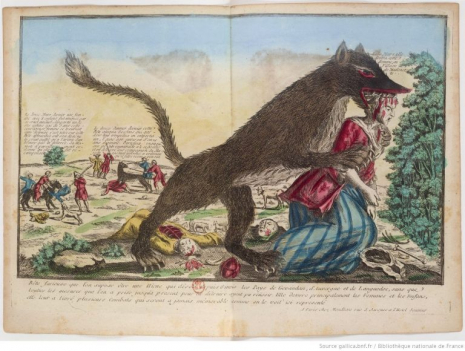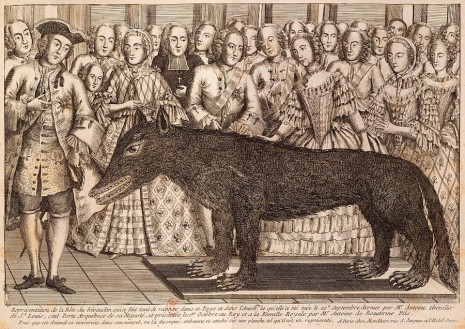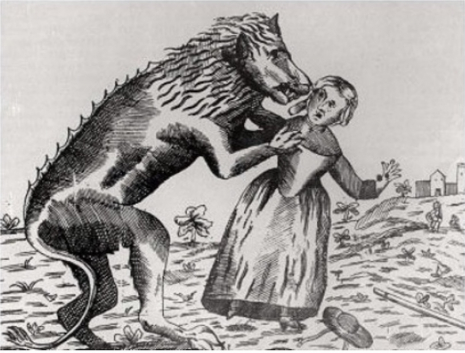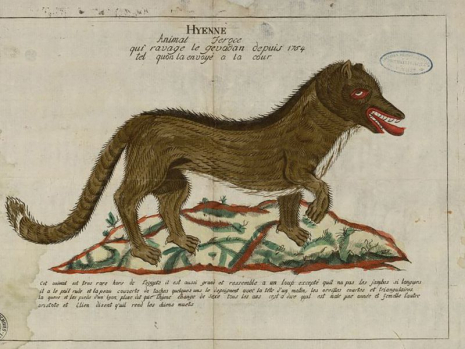
An image depicting an attack by La Bête du Gévaudan, or The Beast of Gévaudan, a predator believed to be a werewolf in France in the mid-1700s.
So before you start to think I’ve completely lost my mind, you should know a 67-page academic paper on the history of killer lycanthropes or some sort of man-eating wolf exists. And, much like any reasonable person, you are probably ready to chalk it all up to storytellers spinning yarns about the messed-up hairy shit that happens when the moon is full. The paper cites a few historical examples of werewolf tall tales such as a story from Scotland about two children who were killed by a wolf in 1743. The problem here is that wolves had been extinct there since 1660. The French Werewolf Epidemic (1520-1630) was France’s version of Europe’s witch trials and executions, but with werewolves. For 110 years, 30 thousand people were accused of being werewolves, tortured in exchange for their confessions, or lack of admission of guilt and died at the stake. Of the many examples of accused werewolfery is of Jacques Rollet, dubbed the Werewolf of Chazes. Rollet lured a fifteen-year-old boy to the woods where he murdered and ate his body. When he was tried for his crime, he confessed to having done the same to other locals, specifically employees of the court system such as lawyers and attorneys. Rollet got the death sentence (like pretty much everyone else back then) but ended up in an insane asylum.
As it pertains to France, the country’s history with wolf-related mythology is long and rich with stories such as the La Bête du Gévaudan, or The Beast of Gévaudan, which for three years terrorized the area. The first attack occurred in April of 1764, and the victim, a young woman tending her flock of sheep, described her assailant as looking “like a wolf, yet not a wolf.” She survived when her sheep went into action, defending the teenage girl from the Beast. Two months later, another young girl, Jeanne Boulet, was attacked and killed by what the residents of Gévaudan thought to be a natural predator, given the fact Boulet was also tending a flock of sheep. Two more fatal attacks would follow within a matter of weeks, both young field workers, a girl, age fifteen, and a boy age sixteen. This would be the start of more than 100 documented fatal attacks in Gévaudan in which most of the victims were partially eaten. The residents of Gévaudan would take up arms, and large rewards were offered for the capture or killing of The Beast of Gévaudan. Experienced hunters and even groups of children would go out in search of the Beast and return with stories of battling a giant wolf (noted in the book Monsters of the Gévaudan: The Making of a Beast). One such incident describes the wolf attacking a group of young children, five boys and two girls in a bog where they were playing. The wolf preyed on the youngest of the group, an eight-year-old boy who he clenched in his massive jaws as the kids attacked the wolf with their make-believe weapons (in this time period, pretend bayonets), finally getting the animal/manimal to release their friend.

A woman trying to fight off The Beast.
Once the news reached the ears of Louis XV, he offered up his own bounty in exchange for the Beast’s head in 1765. After Marie-Jeanne Valet warded off an attack by the Beast while out on the countryside with her sister, Louis XV’s personal gunman (noted to be 71 at the time in The Beast of Gevaudan: La Bete du Gevaudan) went in search of the Beast with a few other men. In September 1765, François Antoine, King Louis’ right hand of the hunt, shot the “Wolf of Chazes,” which was stuffed and put on display in Versailles.

The stuffed ‘Beast’ delivered to Louis XV.
Suddenly, the suspected werewolf killings stopped, only to start again in December and again in the summer of 1767. This inspired the local authorities to start using the term “monster” (a shape “contrary to nature”) to further describe the wild assailant with a penchant for decapitating its victims. Soon, Marquis d’Apcher, a wealthy local resident, took up the charge to hunt down the Beast. d’Apcher was able to shoot the Beast, and, according to legend, ended up entangled with the wolf. Finally, one of the guards on the trip with d’Apcher fired the kill-shot. The Beast’s stomach was filled with human remains and, by all posthumous accounts, did not look anything like a typical wolf. They were also able to ascertain that the animal was solely responsible for 95% of the attacks on humans from 1764 to 1767. Yikes.
So what was Beast of Gévaudan? As werewolves sadly don’t exist (BOO!), speculation as to what kind of animal the Beast was range from a hyena, or perhaps some sort of terrifying lion/wolf hybrid. Sorry if you were, like me, hoping for a medieval wolf-version of Oliver Reed creating all kind of mayhem around the French countryside
A few images of the fabled Beast of Gévaudan follow.

An illustration of the Beast as a wolf/lion hybrid.

The Beast as a hyena.

The Beast (1764).

François Antoine shooting the Beast, September 1765.
Previously on Dangerous Minds:
60s and 70s Mexican pulp novels: Martians, robots, werewolves—and lots of hot babes
Drugs, witchcraft & werewolves: The fantastic weirdness of paranormal magazine Fate
They live? Vampires, werewolves & more mythological creatures from the Cryptid Museum
Teen Werewolves of San Antonio, Texas
‘Werewolf’ allegedly murders his vampire neighbor
Reporter by day, werewolf by night: ‘Wolf Guy,’ bizarre 70s Japanese horror gem starring Sonny Chiba